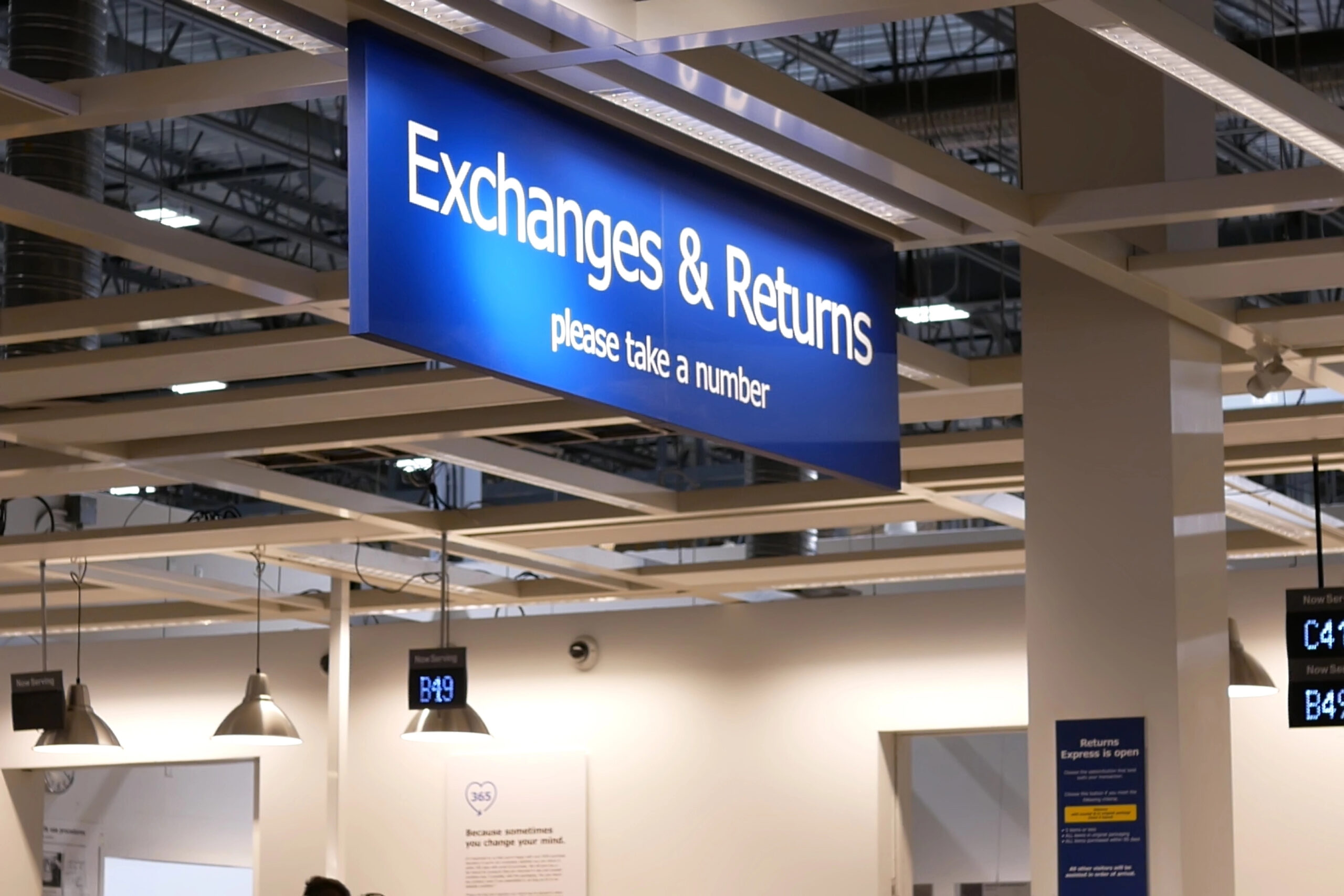
payphoto/Depositphotos.com
June 26, 2025
Can In-Store Returns Get Less Clunky?
A new survey finds retailers still struggling with the extra costs and new workloads created by processing in-store returns while barely benefiting from returnees making an add-on purchase.
The survey of retail executives and store managers, conducted between December 2024 and January 2025 by Retail Systems Research and commissioned by mobile POS developer Jumpmind, found that 43% cited processing online returns in-store as a top challenge, with rising return volumes driving up costs.
More than one in five say their stores were not designed for omnichannel’s advanced customer service functions (order pickup, online returns, etc.), with 41% believing omnichannel fulfillment and returns require new in-store sales rep roles and workflows.
At the same time, the survey found that while 72% of retailers believe this creates opportunities to drive new sales, only 17% of shoppers end up spending more money following a return in-store. The majority — 43% — simply return the item and walk out.
“Those retailers whose returns processes have not been overhauled since their (likely) creation during the pandemic are particularly challenged, as the processes they cobbled together in a hurry are not fit for today’s scale of returns,” said Steve Rowen, managing partner at RSR.
BORIS (buy online, return in-store) promises retailers some benefits, including supporting an easy method for consumers to return merchandise. Once in the store, consumers often make an impulse purchase or can be incentivized to do so.
However, retailers are grappling with higher overall return rates driven by e-commerce growth, as online purchases tend to result in more returns. At the same time, in-store returns are rising as retailers promote free drop-off options while adding fees for mailed returns.
A 2023 study by academic researchers in the UK concluded that returns from online sales — particularly those made in-store — are eroding profitability and urged retailers to adopt a strategic approach to treating returns as a potential profit center. Recommendations included expanding physical storage space, hiring more staff, and investing in IT systems to better track and manage returns.
The study stated, “Many businesses have complex procedures for managing returns. With little senior management oversight of the returns process, retailers find it difficult to pin down crucial information such as the rate of return and the costs of handling a returned item.”
A Shopify blog entry noted that BORIS can lead to inaccurate inventory data, as returned items sit in stockrooms, as well as in-store congestion and longer lines. Shopify suggested creating designated areas for handling in-store returns, although the standard checkout processes returns in many stores.
In March, Kohl’s temporarily stopped accepting Amazon returns at some stores in a test, following social media complaints from store associates about the added workload — from lifting heavy boxes and finding storage space for returned items to managing long customer lines. Several associates also indicated that customers returning Amazon packages rarely take advantage of the 25%-off Kohl’s coupon they receive as an incentive.
Discussion Questions
What do you see as the pain points and solutions to in-store returns?
Can you think of any retailers managing in-store returns adeptly, and what can be learned?
Poll
BrainTrust
Pamela Kaplan
Principal, PK Consulting
Mohamed Amer, PhD
CEO & Strategic Board Advisor, Strategy Doctor
Neil Saunders
Managing Director, GlobalData
Recent Discussions








The problem is mostly driven by online orders being returned to stores. This has pushed up volumes and leaves some stores unable to cope. It can also, in some instances, result in re-salable stock being in the wrong place. Retailers can’t just make returns more restrictive as customers want ease; returns to stores can also cost less than paying for returns to be processed via shipping.
Solutions include having a single view of stock across all channels, a strong reverse-logistics program, proper areas for ecommerce handling in stores – which can be combined with BOPIS services, and the integration of ecommerce and store POS systems.
“single view of stock across all channels”
Reminds me of making in store return at Saks for item bought Saks.com. The sales associate told me that the item would be batch returned to the warehouse to be put back into online inventory.
Then Saks made it known in the press that they unbundled commerce. I never did that again, as I hate the (even more) shipping process to get an item back to where it started.
Maybe symbolic of luxury retail, to keep a store hermetically sealed from anything out of place!
Returns have always been the bane of a retailer’s existence – they are messy, complicated and very few companies want to invest in the proper systems… which ends up costing more in processing and tracking inventory. And for sure ecomm has exacerbated this issue. The ideal situation would be to turn returns in stores into profit centers but as noted above, the only way to do that is for stores to invest in it. Another problem is the people at the HQ level are not always in touch with the stress it puts on the stores and the costs that is needed to make it successful.
Stores are designed to sell thing…to move things out; catering to the inverse of this process is inevitably going to set up conflicts, So I’m going to cut-off this discussion before it starts: the best way to handle returns is to make sure you have very few of them.
Omni-channel returns in store will continue to drive up the returns occurring in store and have become an important part of consumers expectations for the overall user experience. Some of the reasons for this include the ability to avoid shipping costs and feel confident on the timing of their refund. Retailers who are good at this have overcome the major issues resulting on extra steps in processing the return and making the product available for resale in near real time. The key factors in this include:
1) having an omni channel Payment token too simplify the in store return, 2) having a enterprise item file available at every location to simplify the return and expedite the resale process, 3) Have systems in place to enable selling items from any channel from any location, 4) having good analytical data the enables Moving the right product at the right time to outlets or DC’s for resale, 5) and lastly having hardened processes to Quality check an item and rapidly make it available for resale.
Aren’t returns really a customer acquisition and customer retention problem? Easy, free, frictionless returns are supposed to grow my business and retain long term customers, right? Is that really the lesson we’ve learned in the year 2025? Maybe it was the lesson learned in 2005 or even 2015, but is that really where we still are? Aren’t returns one of the biggest profit drains in retail? Do they really have to be free and frictionless? Isn’t the best way to manage returns to do it at point of sale…???…with rules, fees, and some level of managing expectations?
I know, in apparel the whole ‘fit’ issue is mind bogglingly complicated. Returns are going to happen under the best of circumstances. I’ve made it a point to look at a couple of websites to see how they handle fit. The charts, the measurements, the comparisons to the models. Different brands, different fabrics, different drape and handfeel, different specs…oy.
Yes, in store returns can be a nightmare. So stop inviting them.
“Easy, free, frictionless returns are supposed … retain long term”
Oh boy, will Influencers love your store!!!
Nothing more hated than: “Fits true to size, order your normal size”.
UX fail: generic dept store size charts, instead of the label’s own sizing.
Customers often experience long waiting times when returning items, which is a major concern. Self-service kiosks can streamline the process by allowing customers to initiate returns independently and quickly. The integration of mobile apps with in-store systems can also provide real-time updates and faster processing, which enhances the overall return experience.
The survey exposes retail’s open secret: the promise of frictionless returns has created friction everywhere else in the operation. Stores are drowning in a process they never designed for, while customers increasingly game a system that was meant to build loyalty.
Back in the early 2000s, as e-commerce adoption accelerated, reverse logistics created significant challenges that had to be solved to protect margins. E-commerce companies built reverse logistics into their DNA from day one. Traditional retailers are trying to retrofit 20th-century stores for 21st-century omnichannel reality.
From space constraints to staff training, system integration, and incentive misalignment, there’s a lot to solve simultaneously. The role AND layout of the physical store needs a serious revisit in today’s retailing reality. Current store design DNA focuses on customer flow, checkout optimization, real estate maximization, and workforce efficiency. Omnichannel reality requires returns processing, BOPIS fulfillment, cross-channel inventory, and service concentration.
There are distinct layout redesign models worth considering, but in retail, operational elegance often beats strategic brilliance! Sometimes the best customer experience is helping customers make better decisions upfront rather than enabling poor ones after the fact.
Often returns can be converted to a sale. The magic is treating the return as a need satisfaction opportunity. And adding a process like…
1) Why did this not work for you?
2) What would?
3) Let’s do that.
Few retailers are set up for that level of customer solution conversation.
In-store returns are not just about processing a return. They are a key touchpoint in the entire omnichannel journey.
The customer might have bought online, but the moment they step into the store, they expect a smooth and connected experience. If store teams are not equipped for that, it feels disconnected.
Returns should not be treated as a backend task. They deserve the same attention as fulfillment, because they are just as visible to the customer.
When stores are part of the larger omnichannel flow with the right tools, space, and processes, returns can become a moment of loyalty, not a loss.
This survey confirms what we’re seeing across retail: BORIS has become a double-edged sword. While the promise of converting returns into sales sounds compelling, only 17% of customers end up spending more during their return visit. Basically, retailers scrambled to create their own versions of BORIS during the pandemic and have been playing whack-a-mole with operational and profitability challenges ever since.
Returns can’t just be treated as a necessary evil. They need to be reimagined as a strategic touchpoint. The most successful retailers we work with have invested in dedicated return zones, proper staffing models, and integrated technology that treats returns as part of the customer journey rather than an operational burden. Basically, it’s time for retailers to fundamentally rethink their omnichannel fulfillment strategy.